
Frank Eugene Eliason (1878-?), was an American illusionist, magician, and shadowgraphy artist, who used stage names including Dante, Dante the Marvellous, and Frank Frazee.

Frank Eugene Eliason (1878-?), was an American illusionist, magician, and shadowgraphy artist, who used stage names including Dante, Dante the Marvellous, and Frank Frazee.
Born in Salt Lake City, Utah, on 9 January 1878, [1] Franklin (Frank) Eugene Eliason was the son of Mormon pioneer migrants from Sweden, Olof Larsson Eliasson (1836-1920) and Ingar Emma Andersson (1838-1893). [2] [3] An elder brother, Oscar Eliason (1869-1899), who used the stage name Dante the Great, claimed that a maternal ancestor was the Scottish professional magician, John Henry Anderson, (1814-1874) known as “Professor Anderson” and the “Wizard of the North”, but produced no known evidence of a direct link. [4] [5] [6] [7] [8] [9]
After Oscar turned professional in about 1892, [10] [11] Frank began performing alongside him while he was still a teenager. One performance by Oscar in Salt Lake City in October 1894 included a segment by Frank, giving an exhibition in shadowgraphy, a form of entertainment involving the use of hand shadows that would become a mainstay of Frank's later career. [12] Along with Oscar's wife, Virginia Edmunda Hammer (1873–1946), Frank was many times Oscar's assistant in his shows. [13] [14] [15]
In 1897, Frank went on tour with Oscar and Edmunda to Cuba. [16] The following year he joined the couple on a tour that began in Canada, then continued to New Zealand and Australia, where Oscar was promoted as Dante the Great. [17] Frank continued to support his brother on stage during the tour. For example, in a “Simla Séance” act, he played the part of a medium who was purportedly helped by an Indian spirit called “Silverlight”. Audiences were left mystified how he was able to ring bells and blow harmonicas, despite appearing to remain securely tied inside a cabinet, with his mouth full of water. [18] [19] The Australasian tour was highly successful. Oscar received positive press reviews at virtually every stop of many along the way, with a record 101 performances at Sydney's Palace Theatre [20] and a record 11 weeks at Melbourne's St George's Hall. [21] [22] He was on a “farewell” tour of New South Wales when he died after being accidentally shot in November 1899 near Dubbo. [23]
In January 1900, Frank and Edmunda decided to comply with a dying wish expressed by Oscar for his show to continue, [24] and went on a month-long tour to New Zealand, where Frank was promoted as Dante, brother to Dante the Great, with Edmunda as his assistant. [25] Almost certainly without any basis, New Zealand press reports at the beginning of the tour claimed that Frank had taught Oscar the art of conjuring, and most of Oscar's main tricks were the work of Frank's “inventive brain”. [26] Nevertheless, Frank had worked alongside Oscar long enough to know how to perform well, and the show received positive reviews. “While regretting the death of Dante the first, who made himself very popular in Auckland, we must express our satisfaction that his work is so ably carried on by Dante the second,” wrote one reviewer. [27]
Back in Australia, for several months Frank was engaged to perform “feats of magic and mystery” at a new entertainment complex in Adelaide called The Pantheon. [28] In his shows, Frank reproduced tricks his brother had often performed with Edmunda, like “suspending” a woman in mid-air with no visible means of support. [29] However, he also introduced shadowgraphy into the program. [30] From Adelaide, Frank performed a season at Brisbane's Theatre Royal [31] before beginning a period being a travelling performer across Australasia.
From 1901 to mid-1905, Frank would promote himself as Dante the Marvellous and mention in advertising that he was the “brother of the late Dante the Great”. [32] Again, he reproduced many tricks previously performed by Oscar Eliason, including the famous “bullet catch”. [33] [34] [35] and incorporated shadowgraphy. [36] [37] Frank managed to draw good audiences in many locations in Australia from 1901-1904 and then in New Zealand in the first half of 1905. But despite touring for longer, he was never as successful as his brother had been. [38] [39] [40] [41]
Throughout his Australian tour, advertisements for Frank's shows always stated that he was assisted by a “Mademoiselle Camille”. [42] Her identity was not disclosed, but she may have been Sydney-born Elsie Kathleen Caldwell (1882-1914), who travelled overseas with Frank and married him in Madras (now Chennai) in southern India in December 1906. [43] Frank had been performing in India as Dante the Wonderful [44] after putting on shows in Manila [45] and Shanghai that included shadowgraphy. [46] In the western Indian city of Pune, he was reported to have been hospitalised with “enteric” (typhoid fever) before he proceeded to Rangoon and the British Straits Settlements. [47] Frank and his wife, apparently preferring to use the name Kathleen, also went to Manila before sailing to the US from Yokohoma in Japan in June 1909. [48]
When Frank returned to the US with Kathleen, they would begin touring as The Great Dantes, English Wonder Workers. A major component of their show would be derivations of the “Simla Séance” that Frank had performed many times with his brother. At first, they called it an “Australian Simla Séance” [49] but soon changed it to a “Fujiyama Séance”. [50] According to one reviewer, the act presented by the “mysterious” Dantes was “weird, creepy and beyond even the investigative curiosity of stage hands and house attaches”. [51] Another reported that the Dantes’ show was “a continuous source of wonder”. [52] Years later, fellow American magician Eugene Laurant (1875-1944) would pay tribute to their performance. “It was a beautiful act, thoroughly mystifying,” he wrote. “Even today I can say I have never seen the Séance more artistically presented.” [53]
In late 1910, Frank appears to have begun using the stage name “Frank Frazee” as a solo shadowgraphy artist. [54] It was a name that he would keep using for more than a decade, perhaps for the rest of his life. Often at this time he presented his shadowgraphy as part of a vaudeville company. At the Nesbitt Theatre in Pennsylvania in January 1912, for example, he was described as “the human picture machine” who was presenting a cartoon offering in a variety program. [55] Later that year, he made a brief Canadian tour. [56] By then, Frank and Kathleen had given up performing together as the Dantes. They had apparently been living in San Francisco when, at the age of 29, she died in January 1914. [57]
Frank continued with shadowgraphy performances after Kathleen's death, [58] but perhaps demand for his act dwindled as moving pictures became more popular, and he also got a job as a day watchman for the New York printing press manufacturing company, R. Hoe & Co. [59] During World War I, Frank was drafted into the US Army in 1917 as Frank Eliason Frazee. [60] In April 1919, in New York, he married Margaret E. Gordon (1884-?) from Grantown-on-Spey, in the highlands of Scotland. [61] About two years later, Frank was performing in a vaudeville show in New York when he fell, fracturing his skull, and was taken to hospital in a serious condition. [62] This is the last known reference to Frank. His place and date of death has not been traced. Shipping passenger records show that Margaret Eliason-Frazee was still travelling between New York and Britain under that name at least until 1953, describing herself as a married “housekeeper”. [63] However, it seems she always travelled unaccompanied and none of the known records gives any indication whether she was either widowed or divorced at the time. No record has been found of Frank having had any children.

Charles Gilman Norris was an American novelist. A native of Chicago, Norris worked as a journalist for some years before finding success as a novelist and playwright. His first book was The Amateur (1916). His other novels include Salt (1919), Brass: A Novel of Marriage (1921), Bread (1923), Pig Iron (1926), Seed: A Novel of Birth Control (1930), Zest (1933), Hands (1935), and Flint (1944). He also published three plays: The Rout of the Philistines, A Gest of Robin Hood, and Ivanhoe: A Grove Play (1936).

Abraham Owen Woodruff was an American missionary who was a member of the Quorum of the Twelve Apostles of The Church of Jesus Christ of Latter-day Saints. He was also the son of LDS Church president Wilford Woodruff.

Frank Jenne Cannon was the first United States Senator from Utah, who served from 1896 to 1899.
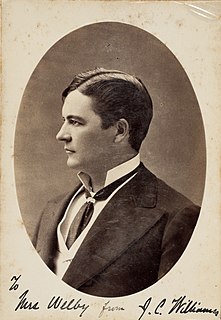
James Cassius Williamson was an American actor and later Australia's foremost impresario, founding J. C. Williamson Ltd.
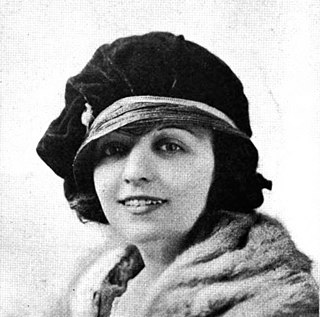
Eva Puck was an American entertainer, a vaudeville headliner who later found success performing in Broadway musical comedies and film.
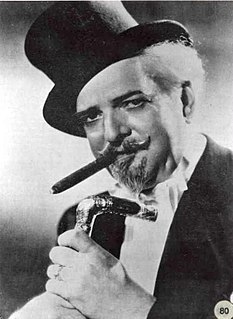
Harry August Jansen was a Danish-born entertainer who settled in the United States. He traveled the world as a professional magician under the name Dante the Magician.

Paul Gilmore was a popular stage actor of the late 19th and early 20th centuries who also appeared in no fewer than 10 silent films. Additionally, he owned and managed for many years the Cherry Lane Theatre in New York City – giving work to such future stars as Robert Walker Sr., Jennifer Jones and Carl Reiner. In his declining years, he and his daughter, Virginia, operated the Gilmore Summer Stock Theatre in Duluth, Minnesota.
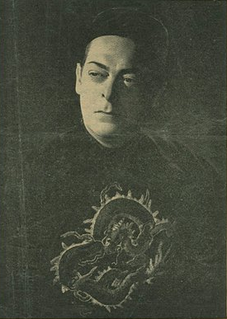
David Tobias "Theodore" Bamberg was an itinerant magician who traveled with his full evening magic show from the early to mid part of the 20th century. In Bamberg's autobiography, Robert Parrish wrote in the introduction that no other great illusionist could match Bamberg's skill. The Fu Manchu show was known for comedy, drama, and a plethora of color.

Herbert Augustus Slade, also known as "Maori" Slade, the Big Maori, the Maori Mauler or the Australian Giant, was a New Zealand boxer of Irish and Māori descent, who fought John L. Sullivan for the heavyweight championship of the world in 1883. This occurred at Madison Square Garden, New York, on 6 August 1883. Sullivan won in the third round. Although Slade lost the fight, he is credited by the press to having knocked Sullivan down in a bar fight.

The 1899 British Isles tour to Australia was the fourth rugby union tour by a British Isles team and the second to Australia; though the first tour in 1888 was a private venture, making the 1899 tour the first official undertaking of Australia. It is retrospectively classed as one of the British Lions tours, as the Lions naming convention was not adopted until 1950.

Frank Atha Westbury, who wrote under the pen names of "Atha" and "Atha Westbury", was a popular and prolific author of mystery adventure novels, children's stories and poetry in late 19th century Australia and New Zealand. Most of his fiction was serialised in newspapers and journals between 1879 and 1905. His two major works were: The Shadow of Hilton Fernbrook, A Romance of Maoriland (1896) and Australian Fairy Tales (1897), which won him a place as one of the better-known writers for children in Victorian-era Australia. Many of his novels were adventure romances set in New Zealand at the time of the New Zealand Wars of the 1860s, which the author experienced as a soldier in the British Army.
Alfred Rolfe, real name Alfred Roker, was an Australian film director and actor, best known for being the son-in-law of the celebrated actor-manager Alfred Dampier, with whom he appeared frequently on stage, and for his prolific output as a director during Australia's silent era, including Captain Midnight, the Bush King (1911), Captain Starlight, or Gentleman of the Road (1911) and The Hero of the Dardanelles (1915). Only one of his films as director survives today.
Steven 'Steve' Eliason is an American politician and a Republican member of the Utah House of Representatives representing District 45 since January 1, 2011.
Edward Irham Cole was an Australian film director and theatrical entrepreneur who specialised in Wild West shows.

Daniel F. Desdunes was a civil rights activist and musician in New Orleans and Omaha, Nebraska.

The 2018 United States House of Representatives elections in Utah were held on November 6, 2018, to elect the four U.S. Representatives from the state of Utah, one from each of the state's four congressional districts. The elections coincided with other states' elections to the House of Representatives, elections to the United States Senate and various state and local elections. Registered political parties in Utah must have at least one of their candidates for House of Representatives get 2% of the vote in their respective election in order to maintain their ballot access in future elections.

Alexander "Alick" Cecil Knox Mackenzie was an Australian cricketer. He played 48 first-class matches for New South Wales and Rest of Australia between seasons 1888/89 and 1906/07. In the Sydney grade competition he is most well known for having played for the Paddington and Waverley clubs.
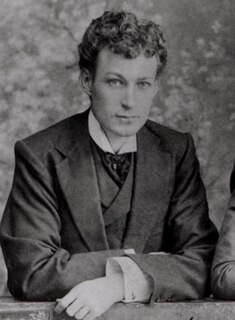
Oscar Eliason (1869–1899), known by the stage name Dante the Great, was an American illusionist and magician.

Robert (Bob) Marion "Doc" Cunningham (1873-1951), was an American illusionist, stunt performer, and showman whose stage names included Zante, Cunning the Jail Breaker, Cunning the Handcuff King, Doc Cunning, The Mental Miracle Man, and Cunning the Supermind.

Virginia "Verge" Edmunda Hammer (1873–1946) was an American entertainer who performed as a magician's assistant, a magician, a "mind reader" and an "illusionary dancer". Her stage names included Electra the Magic Wonder, Mademoiselle Edmunda and Madame Edmunda.